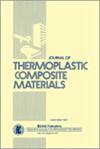Alkali-treated and silanated luffa fiber reinforced poly(butylene succinate) composites: A study of mechanical and water absorption characterization
IF 3.4
4区 材料科学
Q2 MATERIALS SCIENCE, COMPOSITES
引用次数: 0
Abstract
As a degradable polymer material, polybutylene succinate (PBS) has the disadvantages of high cost, slow crystallization rate, and low strength modulus. Reinforcing modification with plant fibers is a popular method. A unique three-dimensional network structure was found in luffa fiber (LF). Compared to other plant fibers, this fiber has excellent mechanical strength due to its unique three-dimensional structure. Its structure allows it to maintain the integrity of the reinforcement phase in the polymer aggregate, overcoming the dispersion and defects of short fiber reinforcement. Herein, the LF was treated with alkali treatment and silanated with three coupling agents and pre-impregnation methods to improve interfacial properties with the PBS matrix. Then it was laminated with polybutylene succinate to prepare a PBS/LF composite board with three layers of LF. The performance of the composite material using the KH550 coupling agent was improved the most. The tensile strength and modulus of the material were increased by 24.9% and 82.9%, respectively, the flexural strength and modulus were increased by 21.7% and 18.5%, and the impact strength was increased by 12.5%. The water absorption weight gain rate is also the lowest, about 3.5%. For the LF-reinforced PBS, the preparation method is simple, and the reinforcement effect is better, that the cost was effectively reduced, and the application field of the PBS green material was expanded. A new possibility for the development of green degradable polymer composites was provided.碱处理和硅烷化的丝瓜纤维增强聚丁二酸丁二醇酯复合材料:机械和吸水特性研究
作为一种可降解聚合物材料,聚丁二酸丁二醇酯(PBS)具有成本高、结晶速度慢、强度模量低等缺点。用植物纤维进行增强改性是一种常用的方法。在丝瓜纤维(LF)中发现了一种独特的三维网络结构。与其他植物纤维相比,这种纤维因其独特的三维结构而具有出色的机械强度。它的结构使其能够保持聚合物骨料中增强相的完整性,克服了短纤维增强的分散性和缺陷。在此,对 LF 进行碱处理,并用三种偶联剂和预浸渍方法对其进行硅烷化处理,以改善其与 PBS 基体的界面性能。然后将其与聚丁二酸丁二醇酯层压,制备出具有三层 LF 的 PBS/LF 复合板。使用 KH550 偶联剂的复合材料性能改善最大。材料的拉伸强度和模量分别提高了 24.9% 和 82.9%,弯曲强度和模量分别提高了 21.7% 和 18.5%,冲击强度提高了 12.5%。吸水增重率也最低,约为 3.5%。LF 增强 PBS 制备方法简单,增强效果较好,有效降低了成本,拓展了 PBS 绿色材料的应用领域。这为开发绿色可降解聚合物复合材料提供了新的可能性。
本文章由计算机程序翻译,如有差异,请以英文原文为准。
求助全文
约1分钟内获得全文
求助全文
来源期刊

Journal of Thermoplastic Composite Materials
工程技术-材料科学:复合
CiteScore
8.00
自引率
18.20%
发文量
104
审稿时长
5.9 months
期刊介绍:
The Journal of Thermoplastic Composite Materials is a fully peer-reviewed international journal that publishes original research and review articles on polymers, nanocomposites, and particulate-, discontinuous-, and continuous-fiber-reinforced materials in the areas of processing, materials science, mechanics, durability, design, non destructive evaluation and manufacturing science. This journal is a member of the Committee on Publication Ethics (COPE).
 求助内容:
求助内容: 应助结果提醒方式:
应助结果提醒方式:


